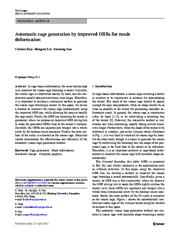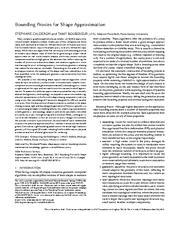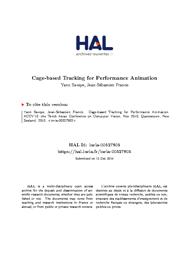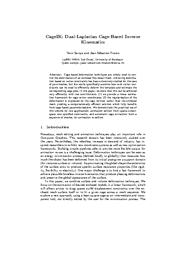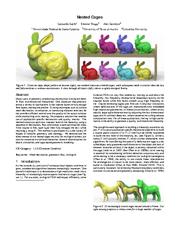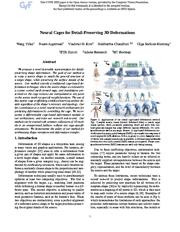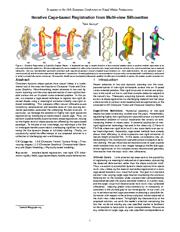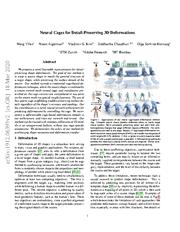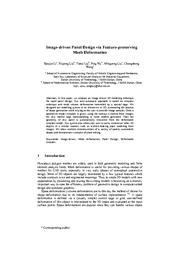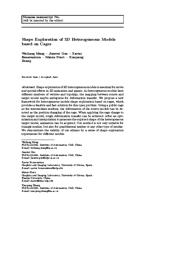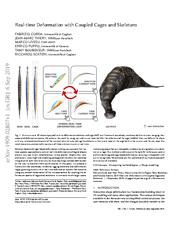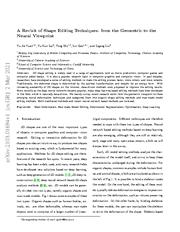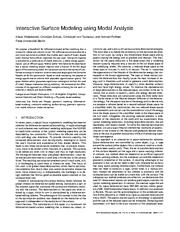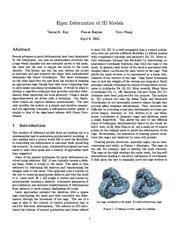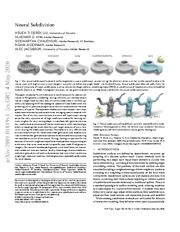A copy of this work was available on the public web and has been preserved in the Wayback Machine. The capture dates from 2017; you can also visit the original URL.
The file type is application/pdf.
Filters
Automatic cage generation by improved OBBs for mesh deformation
2011
The Visual Computer
Finally, the outer surface of the entity is extracted as the coarse cage. Empirical results demonstrate the effectiveness and efficiency of the automatic coarse cage-generation method. ...
Therefore, it is important to develop a convenient method to generate the coarse cage bounding a model. ...
This paper is supported by Natural Science Foundation of China (Nos. 60970150, 60736019, 60933008), and Zhejiang Provincial Natural Science Foundation of China (No. Y1090416). ...
doi:10.1007/s00371-011-0595-6
fatcat:rew5f3h6pnbyfi3i36t2poxahi
Bounding proxies for shape approximation
2017
ACM Transactions on Graphics
We provide extensive experiments on various kinds of input meshes and illustrate the potential applications of our method in scenarios that bene t greatly from coarse, tight bounding substitutes to the ...
We propose a new bounding shape approximation algorithm which takes as input an arbitrary surface mesh, with potentially complex multicomponent structures, and generates automatically a bounding proxy ...
Right: when desactivating scaleadaptive meshing, the large edges at both side of the pinch self-intersect. ...
doi:10.1145/3072959.3073714
fatcat:f23pkq5sozdr3fmrogk3ge3bta
Cage-Based Tracking for Performance Animation
[chapter]
2011
Lecture Notes in Computer Science
Our results show that estimated parameters allow a sufficient silhouette-consistent generation of the enclosed mesh under sparse frame-to-frame animation constraints and large deformation. ...
The main advantages of our novel approach are its linear single pass estimation of the desired surface, easy-to-reuse output cage sequences and reduction in storage size of animations. ...
Cage-Based Animation In the rest of the paper, we use the following terminology. The coarse morphable bounding mesh C and the enclosed mesh M are respectively called the cage and the model. ...
doi:10.1007/978-3-642-19318-7_47
fatcat:worend3tprevlbv5g5rbcmu4gi
CageIK: Dual-Laplacian Cage-Based Inverse Kinematics
[chapter]
2010
Lecture Notes in Computer Science
We demonstrate the practical use of this scheme for two applications: animation edition from sparse screenspace user-specified constraints, and automatic cage extraction from a sequence of meshes, for ...
Cage-based deformation techniques are widely used to control the deformation of an enclosed fine-detail mesh. ...
The system generated automatically the positional constraints using a dense per-vertex mesh displacement mapping from one frame to another to ensure the volume preservation itself. ...
doi:10.1007/978-3-642-14061-7_27
fatcat:ak5eda5rxnhl7dgrii3cow6ap4
Nested cages
2015
ACM Transactions on Graphics
From coarse to fine, each layer then fully encages the next while retaining a snug fit. The method is applicable to a wide variety of shapes of complex geometry and topology. ...
Figure 1 : Given an input shape (yellow on bottom right), our method constructs nested cages: each subsequent mesh is coarser than the last and fully encloses it without intersections. ...
Medical models courtesy of Muhibur Rasheed. ...
doi:10.1145/2816795.2818093
fatcat:w6dnw37jtzgnvjshpl2tt6ovbm
Neural Cages for Detail-Preserving 3D Deformations
2020
2020 IEEE/CVF Conference on Computer Vision and Pattern Recognition (CVPR)
Our method extends a traditional cage-based deformation technique, where the source shape is enclosed by a coarse control mesh termed cage, and translations prescribed on the cage vertices are interpolated ...
The goal of our method is to warp a source shape to match the general structure of a target shape, while preserving the surface details of the source. ...
The robot model in Figures 1 and 9 is from SketchFab, licensed under CC-BY. This work was supported in part by gifts from Adobe, Facebook and Snap. ...
doi:10.1109/cvpr42600.2020.00015
dblp:conf/cvpr/WangAKCS20
fatcat:y3645rotsbginaatxzeii6i64u
Iterative cage-based registration from multi-view silhouettes
2013
Proceedings of the 10th European Conference on Visual Media Production - CVMP '13
In particular, we leverage the problem of highly non-rigid spacetime registration by employing an elasto-plastic coarse cage. ...
Consistent dynamic shape capture from casual videos is a fundamental task at the cross-fertilization of Computer Vision and Computer Graphics. ...
The automatic coarse cage-generation for behavior-specific deformation is a difficult problem that has relatively attracted few attention, but having promising solutions using oriented bounding box [Xian ...
doi:10.1145/2534008.2534010
dblp:conf/cvmp/Savoye13
fatcat:l3xg24wrafe7fg5bqogr65m25u
Neural Cages for Detail-Preserving 3D Deformations
[article]
2020
arXiv
pre-print
Our method extends a traditional cage-based deformation technique, where the source shape is enclosed by a coarse control mesh termed cage, and translations prescribed on the cage vertices are interpolated ...
The goal of our method is to warp a source shape to match the general structure of a target shape, while preserving the surface details of the source. ...
The robot model in Figures 1 and 9 is from SketchFab, licensed under CC-BY. This work was supported in part by gifts from Adobe, Facebook and Snap. ...
arXiv:1912.06395v2
fatcat:7dl6zaddrvgsxcvogpol2s3cr4
Image-Driven Panel Design via Feature-Preserving Mesh Deformation
[chapter]
2011
IFIP Advances in Information and Communication Technology
Once a parametric model template is given, using the contour extracted from images, the new control cage corresponding to mesh models generated. ...
Our semi-automatic approach is based on template technique and mesh volume deformation controlled by a special cage. ...
The first step of the CB 0 generation algorithm is to compute the bounding box of the initial dense mesh model M by principal component analysis (PCA); the so constructed bounding box captures the major ...
doi:10.1007/978-3-642-18336-2_5
fatcat:or3qb3bzxnh4jbg56ayephcj4i
Shape exploration of 3D heterogeneous models based on cages
2016
Multimedia tools and applications
Our method is not only suitable for triangle meshes, but also for quadrilateral meshes or any other type of meshes. ...
Using a public cage as the intermediate medium, the deformation of the source models can be denoted as the position changing of the cage. ...
Here we just try to make some coarse correspondence to generate a reasonable result from the the visual point of view. ...
doi:10.1007/s11042-016-3642-5
fatcat:cxs26mfh3ne73atcs2nisxnbfi
Real-time Deformation with Coupled Cages and Skeletons
[article]
2019
arXiv
pre-print
By coupling the deformation spaces of cages and skeletons, we access a much larger space, containing poses that are impossible to obtain by acting solely on a skeleton or a cage. ...
Skeleton-based and cage-based deformation techniques represent the two most popular approaches to control real-time deformations of digital shapes and are, to a vast extent, complementary to one another ...
Cage-based methods derive directly from the Free Form Deformation [Sederberg and Parry 1986] and allow to deform a volume bounded by a control mesh. ...
arXiv:1909.02807v1
fatcat:3yf3zeeuc5aqzbfmdos4q6iuea
A Revisit of Shape Editing Techniques: from the Geometric to the Neural Viewpoint
[article]
2021
arXiv
pre-print
We mainly survey recent research works from the geometric viewpoint to those emerging neural deformation techniques and categorize them into organic shape editing methods and man-made model editing methods ...
3D shape editing is widely used in a range of applications such as movie production, computer games and computer aided design. ...
Yoshizawa et al. [144] propose to extract a skeletal mesh from the dense mesh model. ...
arXiv:2103.01694v1
fatcat:lhgswnemnbhvrazl76qhz5rhmy
Interactive surface modeling using modal analysis
2011
ACM Transactions on Graphics
Based on mesh coarsening, we propose an energy approximation scheme with adjustable approximation quality. ...
Motivated by the observation that a typical modeling session requires only a fraction of the full shape space of the underlying model, we use second and third derivatives of a deformation energy to construct ...
Edge-collapse schemes implicitly generate a map from the vertices of the fine to the vertices of the coarse mesh: for every vertex of the fine mesh there is exactly one vertex on the coarse mesh to which ...
doi:10.1145/2019627.2019638
fatcat:loc5zfawwjewtb5zvqaz5iwisu
Eigen deformation of 3D models
2012
The Visual Computer
The direct techniques on the other hand free the user from the burden of creating an appropriate cage though they take more computing time to solve larger non-linear optimizations. ...
Our framework creates an implicit skeleton automatically. ...
Meshes used in this paper were obtained from AIM@Shape Shape Repository. This work is supported by the National Science Foundation ...
doi:10.1007/s00371-012-0705-0
fatcat:ed23abnr4zbcjm4iexsaboun6q
Neural Subdivision
[article]
2020
arXiv
pre-print
For any training shape, we stochastically generate diverse low-resolution discretizations of coarse counterparts, while maintaining a bijective mapping that prescribes the exact target position of every ...
During inference, our method takes a coarse triangle mesh as input and recursively subdivides it to a finer geometry by applying the fixed topological updates of Loop Subdivision, but predicting vertex ...
We obtained our test models from Thingi10K [Zhou and Jacobson 2016] and we thank all the artists for sharing a rich variety of 3D models. ...
arXiv:2005.01819v1
fatcat:uqdbp7435vbgjan6emvhhfptvq
« Previous
Showing results 1 — 15 out of 856 results

